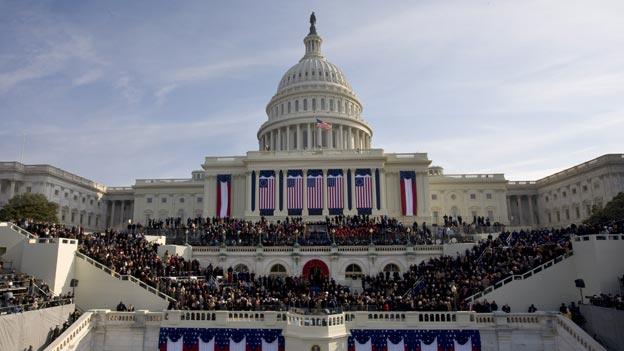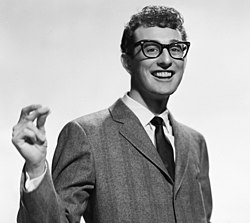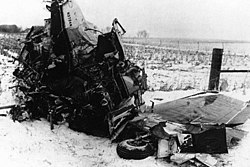
Hi Everybody!!
Please come in and meet my blue jay. He is my blue bird of Happiness. I went out on the deck this morning to put some seed out. It was chilly-willy! I caught a quick chill and shivered. Of course, I was barefoot and in my pjs, might have had something to do with it.
Anyway, I had a second shiver and it made me think of the phrase: February made me shiver, with every paper I delivered.... How strange for that song used in the first Inauguration, to pop up again around a second one. It was Bye, Bye Miss American Pie by Don Maclean.
I began to sing it. I knew all the words, we all knew all the words. But did we have any idea what the words were about? I don't think so. At least I did not, but you know I am always the last to find out about anything! What did he mean with bye bye Miss American Pie, drove my chevy to the levy but the levy was dry.......And Exactly what Day was it when the Music Died?
As You know by now, Google knows everything. So I took a stroll through the Google Index and found all the answers to these questions! I bring them to share with You. I ended up on memory lane going back in time to when I was 10. I was Singing Peggy Sue back then!
Enjoy our little tour into a Famous Song
(and, by all means, please sing along!)
http://www.youtube.com/watch?v=wwImsK2Ggjc
Blue Jay
From Wikipedia, the free encyclopedia
The Blue Jay (Cyanocitta cristata) is a passerine bird in the family Corvidae, native to North America. It is resident through most of eastern and central United States and southern Canada, although western populations may be migratory. It breeds in both deciduous and coniferous forests, and is common near and in residential areas. It is predominately blue with a white chest and underparts, and a blue crest. It has a black, U-shaped collar around its neck and a black border behind the crest. Sexes are similar in size and plumage, and plumage does not vary throughout the year. Four subspecies of the Blue Jay are recognized.
The Blue Jay mainly feeds on nuts and seeds such as acorns, soft fruits, arthropods, and occasionally small vertebrates. It typically gleans food from trees, shrubs, and the ground, though it sometimes hawks insects from the air. It builds an open cup nest in the branches of a tree, which both sexes participate in constructing. The clutch can contain two to seven eggs, which are blueish or light brown with brown spots. Young are altricial, and are brooded by the female for 8–12 days after hatching. They may remain with their parents for one to two months.
The bird's name derives from its noisy, garrulous nature,[2] and it sometimes also called a "jaybird"
 | |
| Conservation status | |
|---|---|
| Scientific classification | |
| Kingdom: | Animalia |
| Phylum: | Chordata |
| Class: | Aves |
| Order: | Passeriformes |
| Family: | Corvidae |
| Genus: | Cyanocitta |
| Species: | C. cristata |
| Binomial name | |
| Cyanocitta cristata (Linnaeus, 1758) | |


United States presidential inauguration
From Wikipedia, the free encyclopedia
http://en.wikipedia.org/wiki/United_States_presidential_inauguration
The inauguration of the president of the United States takes place during the commencement of a new term of a president of the United States, which is every four years on January 20. Prior to theTwentieth Amendment, the date was March 4, the day of the year on which the Constitution of the United States first took effect in 1789; the last inauguration to take place on the older date was Franklin D. Roosevelt's first one on March 4, 1933. The day a presidential inauguration occurs is known as "Inauguration Day".
The only inauguration element mandated by the United States Constitution is that the president make anoath or affirmation before that person can "enter on the Execution" of the office of the presidency. However, over the years, various traditions have arisen that have expanded the inauguration from a simple oath-taking ceremony to a day-long event, including parades, speeches, and balls.
From the presidency of Andrew Jackson through that of Jimmy Carter, the primary Inauguration Day ceremony took place on the Capitol's East Portico.[1] Since the 1981 inauguration of Ronald Reagan, the ceremony has been held at the Capitol's West Front. The inaugurations of William Howard Taft in 1909 and Reagan in 1985 were moved indoors at the Capitol due to cold weather. The War of 1812 and World War II caused two inaugurations to be held at other locations in Washington, D.C.
Since Chief Justice Oliver Ellsworth swore in President John Adams, no chief justice has missed an Inauguration Day. When Inauguration Day has fallen on a Sunday, the chief justice has administered the oath to the president either on inauguration day itself or on the Sunday privately and the following Monday publicly. The next scheduled public presidential inauguration ceremony, swearing-in Barack Obama to begin his second four-year term in office, will take place on Monday, January 21, 2013. The President will make a private oath of office on Sunday, January 20
The following vid is a glimpse of the entertainment at the first Inauguration:
http://www.youtube.com/watch?v=LjD5d_ZrnLM
http://www.youtube.com/watch?v=Gct1NltP4j4
American Pie (song)
From Wikipedia, the free encyclopedia
| "American Pie" | |||
|---|---|---|---|
 | |||
| Single by Don McLean | |||
| from the album American Pie | |||
| B-side |
"Empty Chairs" (promo)
"American Pie part 2" (first release) | ||
| Released | November 1971 (original) November 1991 (re-release) | ||
| Format |
Vinyl record (original)
CD, cassette, vinyl (reissue) | ||
| Recorded | May 26, 1971 | ||
| Genre | Rock, folk rock | ||
| Length | 8:33 (LP) 4:11 (Single Part 1) 4:31 (Single Part 2) | ||
| Label | United Artists | ||
| Writer(s) | Don McLean | ||
| Producer | Ed Freeman for The Rainbow Collection, Ltd. | ||
| Don McLean singles chronology | |||
| |||
http://www.youtube.com/watch?v=32d2oZh_DI4
| Don McLean | |
|---|---|
 Don McLean performing at the Royal Albert Hall in 2012 | |
| Background information | |
| Birth name | Donald McLean |
| Born | October 2, 1945 New Rochelle, New York |
| Genres | Folk, folk rock |
| Occupations | Singer-songwriter, musician |
| Instruments | Vocals, guitar banjo, piano |
| Years active | 1969–present |
| Labels | United Artists EMI America |
| Website | www.don-mclean.com |
http://en.wikipedia.org/wiki/Buddy_Holly
Buddy Holly
From Wikipedia, the free encyclopedia
| Buddy Holly | |
|---|---|
 Buddy Holly in 1957 | |
| Background information | |
| Birth name | Charles Hardin Holley |
| Born | September 7, 1936 Lubbock, Texas, U.S. |
| Died | February 3, 1959 (aged 22) Grant Township, Cerro Gordo County, Iowa, U.S. |
| Genres | Rock and roll, rockabilly, Lubbock sound |
| Occupations | Singer-songwriter, musician |
| Instruments | Vocals, guitar, piano, violin |
| Years active | 1955–1959 |
| Labels | Decca, Brunswick, Coral |
| Associated acts | The Crickets, The Picks |
| Notable instruments | |
| Fender Stratocaster | |
Death
Holly was offered a spot in the Winter Dance Party, a three-week tour across the Midwest opening on January 23, 1959, by the GAC agency,[citation needed] with other notable performers such as Dion and the Belmonts, Ritchie Valens, and J. P. "The Big Bopper" Richardson. He assembled a backing band consisting of Tommy Allsup (guitar), Waylon Jennings (bass) and Carl Bunch (drums), and billed them as The Crickets.[citation needed]
Following a performance at the Surf Ballroom in Clear Lake, Iowa, on February 2, 1959, Holly chartered a small airplane to take him to the next stop on the tour. Holly, Valens, Richardson and the pilot Roger Peterson were killed en route to Moorhead, Minnesota, when their plane crashed soon after taking off from nearby Mason City in the early morning hours of February 3.[21] There was a snowstorm, and the pilot was not qualified to fly by instruments only. Bandmate Waylon Jennings had given up his seat on the plane, causing Holly to jokingly tell Jennings, "I hope your ol' bus freezes up!" Jennings shot back facetiously, "Well, I hope your ol' plane crashes!" It was a statement that would haunt Jennings for decades.[22] "Although the plane came down only five miles northwest of the airport, no one saw or heard the crash", wrote rock performer, archivist and music historian, Harry Hepcat, in his article about Buddy Holly. "The bodies lay in the blowing snow through the night...... February indeed made us shiver, but it was more than the cold of February that third day of the month in 1959. It was the shiver of a greater, sometimes senseless, reality invading our sheltered, partying, teenaged life of the 50's."[23]
Holly's funeral was held on February 7, 1959, at the Tabernacle Baptist Church in Lubbock.[24] The service was officiated by Ben D. Johnson, who had presided at the Hollys' wedding just months earlier. The pallbearers were Jerry Allison, Joe B. Mauldin, Niki Sullivan, Bob Montgomery, Sonny Curtis and Phil Everly.[25] Waylon Jennings was unable to attend due to his commitment to the still-touring Winter Dance Party. Holly's body was interred in the City of Lubbock Cemetery in the eastern part of the city. His headstone carries the correct spelling of his surname (Holley) and a carving of his Fender Stratocaster guitar.

http://www.youtube.com/watch?v=AzgSFJEsg1I
 Monument at the crash site, September 16, 2003. | |
| Accident summary | |
|---|---|
| Date | Tuesday February 3, 1959 |
| Type | Controlled flight into terrain |
| Site | near Clear Lake, Iowa, United States 43°13′12″N 93°23′0″W |
| Passengers | 3 |
| Crew | 1 |
| Fatalities | 4 (all) |
| Aircraft type | Beechcraft Bonanza |
| Operator | Dwyer Flying Service inMason City, Iowa |
| Registration | N3794N |
| Flight origin | Mason City Municipal Airport |
Crash
When the show ended, Carroll Anderson drove Holly, Valens, and Richardson to the airport.[10] The plane departed from the ramp and taxied to then-Runway 17 at around 12:55 am Central Time on Tuesday, February 3.[11] The weather report indicated light snow with a ceiling of 5,000 feet and winds from 29 to 37 mph. Though there were indications of deteriorating weather along the route, the weather briefings Peterson received failed to relay the information.[12] The Civil Aeronautics Board (CAB)—an agency later replaced by the National Transportation Safety Board (NTSB)—investigated the crash. The results of the CAB investigation suggest that, soon after takeoff, Peterson became disoriented due to the unfamiliar way the attitude indicator in the aircraft functioned, combined with an inability to find a point of visual reference on a starless night with no visible lights on the ground.[13] He lost control of the plane when the tip of the right wing hit the ground. The aircraft tumbled across a bean field belonging to Albert Juhl. The Bonanza was at a slight downward angle and banked heavily to the right when it struck the ground at around 170 miles per hour (270 km/h). The plane tumbled and skidded another 570 feet (170 m) across the frozen landscape before the crumpled wreckage came to rest against a wire fence at the edge of Juhl's property.[14]
Meanwhile, Dwyer, owner of the plane and the flight service company, who had witnessed the takeoff, decided to establish radio contact, but all attempts were unsuccessful.[11] The next morning, when Hector Airport in Fargo, North Dakota, had not heard from Peterson, Dwyer contacted authorities and reported the aircraft missing. Dwyer took off in his Cessna 180 and flew Peterson's intended route. Within minutes he spotted the wreckage less than 6 miles (10 km) northwest of the airport (43°13′13″N 93°22′53″WCoordinates: 43°13′13″N 93°22′53″W).[14] The Sheriff's office dispatched Deputy Bill McGill, who drove to the wreck site.[13] The bodies of Holly and Valens lay near the plane. Richardson's body was thrown over the fence and into the cornfield of Juhl's neighbor Oscar Moffett. Peterson's body was entangled in the plane's wreckage.[14] With the other participants on "The Winter Dance Party" en route to Moorhead, it fell to Surf Ballroom manager Carroll Anderson, who drove the musicians to the airport and witnessed the plane's takeoff, to make positive identifications of the musicians.[15] The county coroner Ralph Smiley declared that all four had died instantly from "gross trauma" to the brain.[14]
The first song to commemorate the musicians was Three Stars by Eddie Cochran.[1] The accident was later the subject of the 1971 Don McLeansong American Pie. The song dubbed it in popular culture as "The Day The Music Died,"[22] which for McLean, symbolized the "loss of innocence" of the early rock-and-roll generation.[1][23]The DAY THE MUSIC DIED
Mason City, Iowa
February 3, 1959
...this is brendasue signing off from Rainbow Creek. See You next time!
Of Course, one more great performance
http://www.youtube.com/watch?v=j0VPxYAM698
O+O


























No comments:
Post a Comment
Hi Everybody! Please say hello and follow so I know you are here! Due to the inconsideration of people trying to put commercials on my blog comment area, I have restricted use of anonymous posts. Sorry that some hurt all.
My public email is katescabin@gmail.com No spammers or trolls